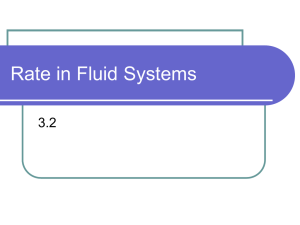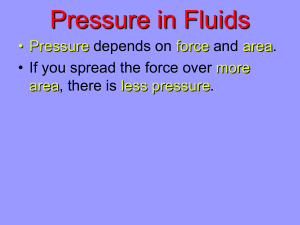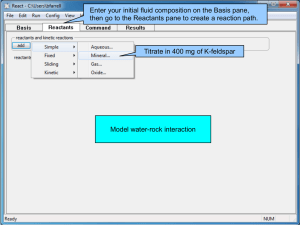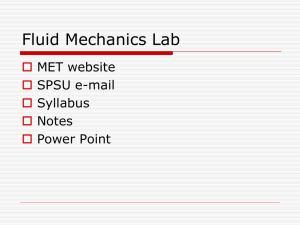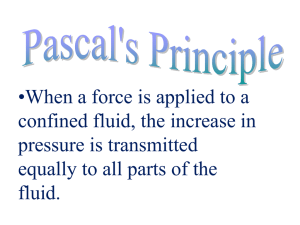Non-commercial Fluid Recycling Pit
advertisement
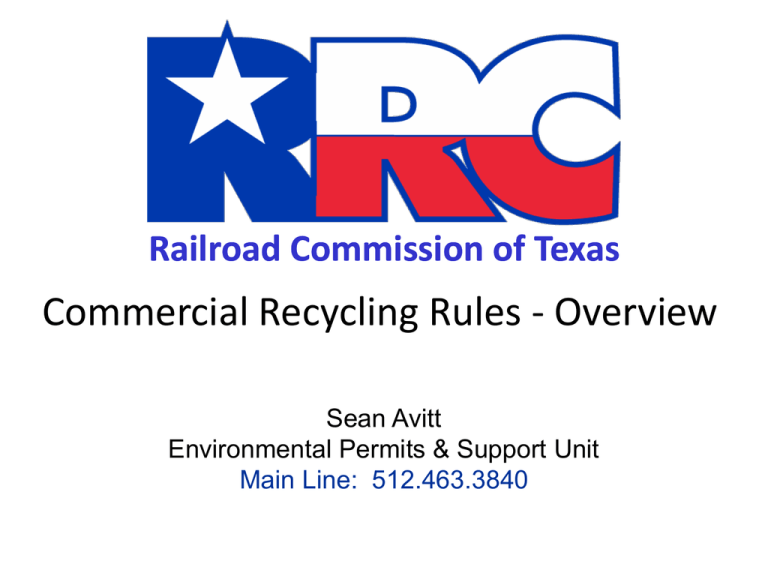
Railroad Commission of Texas Commercial Recycling Rules - Overview Sean Avitt Environmental Permits & Support Unit Main Line: 512.463.3840 Disclaimer / Overview • This is the highlights… This presentation is not intended to be, nor is it, a complete guide. There is no substitution for reading the rules yourself, or having professional consultation. • • • • Background information Non-Commercial Rules Commercial Rules Pit Permit Tips (if time allows) 2 Environmental Permitting BACKGROUND INFORMATION 3 Environmental Permits & Support • Covers the management of oil and gas waste at or near the surface • Includes all disposal methods other than injection wells • Permitting and Management of: • Pits • Landfarming and Landtreatment • Recycling • Reclamation Plants • Separation Facilities • Discharges • Waste Haulers • Others 4 Environmental Permits & Support • Covers the management of oil and gas waste at or near the surface • Includes all disposal methods other than injection wells • Permitting and Management of: • Pits • Landfarming and Land treatment • Recycling – Water and Roadbase • Reclamation Plants • Separation Facilities • Discharges • Waste Haulers • Others 5 Associated Rules and Publications • • • • • Rule 8 – Water Protection Rule 57 – Reclamation Plants Rule 78 – Financial Security Rule 98 – Hazardous Waste Management Chapter 4, Subchapter B – Commercial Recycling 6 Associated Rules and Publications • • • • • Rule 8 – Water Protection Rule 57 – Reclamation Plants Rule 78 – Financial Security Rule 98 – Hazardous Waste Management Chapter 4, Subchapter B – Commercial Recycling • Surface Waste Management Manual http://www.rrc.state.tx.us/oil-gas/applications-and-permits/environmentalpermit-types-information/ 7 Rule 8 Background • Environmental Permitting’s Authority • Subsections • • (b) No Pollution (d) Pollution Control • • • • Prohibited / Authorized Disposal Prohibited / Authorized Pits Authorized Pit Backfilling requirements Prohibited / Authorized Recycling 8 Rule 8 Background – Define Authorized • Authorized (by Rule) – The disposal method as defined by rule can be utilized without permit from the Commission • Authorized disposal methods may have specific requirements that must be followed 9 Pit and Recycling RULE 8 AMENDMENTS 10 Authorized Fluid Recycling Non-commercial Fluid Recycling – “The recycling of fluid produced from an oil or gas well including produced formation fluid, work over fluid, and completion fluid, including [frac fluids] on an existing commission-designated lease or drilling unit... or upon land leased or owned by the operator for the purposes of operation of [a noncommercial disposal well (§3.9) or a noncommercial injection well (§3.46)]… where the operator … treats or contracts … for treatment, and may accept such fluid from other leases or operators.” 11 Authorized Fluid Recycling Non-commercial Fluid Recycling – “The recycling of fluid produced from an oil or gas well including produced formation fluid, work over fluid, and completion fluid, including [frac fluids] on an existing commission-designated lease or drilling unit... or upon land leased or owned by the operator for the purposes of operation of [a noncommercial disposal well (§3.9) or a noncommercial injection well (§3.46)]… where the operator … treats or contracts … for treatment, and may accept such fluid from other leases or operators.” 12 Authorized Fluid Recycling Non-commercial Fluid Recycling – “The recycling of fluid produced from an oil or gas well including produced formation fluid, work over fluid, and completion fluid, including [frac fluids] on an existing commission-designated lease or drilling unit... or upon land leased or owned by the operator for the purposes of operation of [a noncommercial disposal well (§3.9) or a noncommercial injection well (§3.46)]… where the operator … treats or contracts … for treatment, and may accept such fluid from other leases or operators.” 13 Authorized Fluid Recycling Non-commercial Fluid Recycling – “The recycling of fluid produced from an oil or gas well including produced formation fluid, work over fluid, and completion fluid, including [frac fluids] on an existing commission-designated lease or drilling unit... or upon land leased or owned by the operator for the purposes of operation of [a noncommercial disposal well (§3.9) or a noncommercial injection well (§3.46)]… where the operator … treats or contracts … for treatment, and may accept such fluid from other leases or operators.” 14 Authorized Fluid Recycling Non-commercial Fluid Recycling – The recycling of fluid produced from an oil or gas well including produced formation fluid, work over fluid, and completion fluid, including [frac fluids] on an existing commission-designated lease or drilling unit... or upon land leased or owned by the operator for the purposes of operation of [a noncommercial disposal well (§3.9) or a noncommercial injection well (§3.46)] is authorized by Chapter 4, Subchapter B where the operator … treats or contracts … for treatment, and may accept such fluid from other leases or operators. 15 What’s Recycling? Recycle- “To process and/or use or re-use oil and gas wastes as a product for which there is a legitimate commercial use and the actual use of the recyclable product.” Injection is not recycling. 16 Authorized Reuse • Reuse as makeup water, or other use in the wellbore of an oil, gas or geothermal well. • Reuse in any other manner pursuant to a permit issued by another state or federal agency • Any reuse if the water is distilled • No discharge to waters of the state without permit 17 Rule 8 – Authorized Pits • Authorized pits include: • • • • • Non-commercial Fluid Recycling Pit Reserve pit Completion/Workover pit (including frac flow-back) Mud circulation pit Fresh makeup water pit • Authorized pits must be dewatered and backfilled in accordance with schedules found in Rule 8 • Rule 3.8(b) “No pollution” ALWAYS applies. 18 Authorized Fluid Recycling Pit Non-commercial Fluid Recycling Pit “Pit … for the storage of fluid for the purpose of Non-commercial Fluid Recycling or for the storage of treated fluid.” 19 Non-com. Fluid Recycling Pit requirements • Authorizes Non-com. Fluid Recycling Pits to store fluid from an oil or gas well that will be treated and reused if: ̶ ̶ ̶ ̶ ̶ Pit is lined Liner has a hydraulic conductivity of 1x10-7 cm/s or less Two feet of freeboard is maintained, and Pit is emptied and inspected annually or it has a leak detection system (LDS) that is monitored monthly District registration and landowner permission 20 Rule 8 - Permitted Pits • If a pit is not authorized by Rule 8, a Form H-11 must be filed with Environmental Permits and a permit issued before use of the pit can begin. • Examples of types of pits that require a permit: • • • • • • • • Commercial Fluid Recycling Pit Disposal Pit Collecting Pit Emergency Saltwater Storage Pit Brine Pit Washout Pit Skimming Pit Gas Plant Evaporation/Retention Pit 21 Rule 8 – Authorized Disposal • Burial at that well site • Dewatered freshwater drilling muds >3,000 mg/L Cl • Cuttings associated with freshwater or oil-based muds >3,000 mg/L Cl • Freshwater drilling muds <3,000 mg/L Cl • Dewatered completion/workover pit wastes • Landfarming on that lease • Freshwater drilling muds <3,000 mg/L Cl • Burial in an Non-commercial Fluid Recycling Pit • Dewatered wastes from a Non-com Fluid Recycling Pit • Rule 3.8(b) “No pollution” ALWAYS applies. 22 New Rule 8 Amendments for Pits & Recycling • Completion/Workover pits frac flowback storage clarification • Clarifies that no authorized pits may be placed in the 100-year flood plain – Can be approved by District Director – May request hearing if denied 23 What’s authorized, again? Non-Com. Fluid Recycling: – “On-Lease” fluid treatment for reuse • “Downhole” • Other State/Federal Permit • As distilled water – Pit for storage and treatment – Burial of dewatered recycling wastes in pit – Transport of waste and treated fluid Must Be Permitted: – Commercial Recycling under Chapter 4, Subchapter B – Waste Hauling under Ch.4, Sub.B – Reuses not authorized by Rule 8 – Discharge 24 Commercial Recycling Rules CHAPTER 4, SUBCHAPTER B 25 Chapter 4, Subchapter B Divisions Six Divisions for Commercial Recycling Rules 1. General Requirements 2. On-Lease Solid Waste Recycling 3. Off-Lease or Centralized Solid Waste Recycling 4. Stationary Solid Waste Recycling 5. Off-Lease Fluid Recycling 6. Stationary Fluid Recycling (Non-com. Fluid Recycling authorized by Rule 8) 26 General Requirements (highlights) • Permit will prohibit speculative waste accumulation • Engineering and geological work products must be signed by their respective Texas-registered professionals • All oil and gas waste and recyclable product should be stored in lined permitted or authorized pits, or above-ground storage tanks. 27 Solid Waste Recycling – Divisions 2, 3 & 4 • Treating O&G solids to create road base that can be used in the construction of lease roads, well pads, and county roads • Rule establishes leachability standards for metals, chlorides, TPH and benzene and a minimum compressive strength requirement • Road base product may have no more than 15 percent weight loss after 12 cycles of wetting and drying in Trial Run 28 Roadbase Analytical Requirements 29 On-Lease Solid Waste Recycling - 1 year • Treating O&G solids for reuse as roadbase from one lease or unit for reuse by the Generator §4.218. General Permit Provisions. – Surface Owner Permission – 72-hour District Office Notification before siting §4.219. Minimum Permit Provisions for Siting. – Not in a 100-year flood plain – Not in a “sensitive area” as defined by §3.91 – Not within 150 feet of surface water or water wells 30 On-Lease Solid Waste Recycling - 1 year §4.214. & §4.220. Facility Design and Construction. – – – – – Typical Layout Storage liners w/ thicknesses, cross-sections, plan view Storage must be above high water table and surrounded by berms Storm water plan for a 25-year 24-hour rainfall event No discharge, No pollution §4.215. & §4.221. Facility Operations. – – – – – – Process Description Inert materials & chemicals Waste acceptance plan Records of incoming waste, treated, recyclable material and testing Max. volumes & holding times Trial run of 1,000 cubic yards 31 Facility Diagram Dimensions Storage Pit Processing Pad 6 in. thick concrete Equipment 500 500 500 Tanks 32 Process Flow Diagram Incoming waste tested and accepted Storage Tank Chemicals Final testing prior to reuse 33 On-Lease Solid Waste Recycling - 1 year §4.216. & §4.222. Facility Monitoring. – – – – Sampling Plan (a composite of four 200 ton grab samples) Regular facility inspections Quarterly Report of records and analytical, and Location of recyclable material used and notification of landowner §4.217. & §4.223. Facility Closure. – – – – Remove all waste Clean/Remove all storage and equipment Return surface to original condition Soil sampling 34 Off-Lease or Centralized Solid Waste - 2 years • Treating O&G solids for reuse as roadbase from multiple leases or units • All applicable requirements from On-Lease Roadbase and… §4.238. Notice. ̶ ̶ Notice of surface owner and adjoining property owners Including a copy of the application and how to protest §4.239. General Permit Provisions. ̶ Financial Security • A bond or letter of credit filed with the Commission greater than or equal to the amount required to close the facility 35 Off-Lease or Centralized Solid Waste - 2 years §4.232. Minimum Siting Information. – General site information • Site description, highway map, address – Site specific environmental information with sources • Precipitation/evaporation, topography, 100-year flood plain, depth to shallowest groundwater, geologic & soil maps 36 Minimum Siting Information USGS Topographic Map http://nationalmap.gov/ustopo/index.html Lat. 27d 45’ 23” Long.-98d 52’ 39” County Road map Scale: 1” = 4 miles 37 Underlying subsoil (Geology) www.twdb.state.tx.us/groundwater/ aquifer/GAT Soil Information http://websoilsurvey.nrcs.usda.gov 38 Off-Lease or Centralized Solid Waste - 2 years §4.233. Minimum Real Property Information. – Lease agreement with surface owner and plats with • section/survey lines, facility boundary, adjoining tracts with surface owners indicated, and distance to receptors within 500 feet 39 Survey Plat N Facility T & N.O.R.R.C.O S. AVITT A-047 1.2 acres A-125 1 inch = 500 feet V. Lang A-126 40 Offset Landowners A Mr. & Mrs. Brown 123 Sesame Street Victoria, TX B C D E Count Chocula Facility 456 Sugar Drive Transylvania, TX F Billy Madison 911 Porsche Court Austin, TX 41 Receptors within 500 feet 200 feet 42 http://wiid.twdb.state.tx.us 1 inch = 500 feet 43 Off-Lease or Centralized Solid Waste - 2 years §4.234. & §4.241. Facility Design and Construction. – Facility diagram – Monitor wells • Boring logs (USCS), well completion logs, survey elevations, and potentiometric map §4.235. & §4.242. Facility Operations. – Plan to control unauthorized access – Estimated duration of operation §4.236. & §4.243. Facility Monitoring. – Quarterly report including monitor well analyses – Records of commercial sales or location of reuse by Generator §4.237. & §4.244. Facility Closure. – Soil and groundwater sampling – Plug monitor wells 44 Stationary Solid Waste Recycling - 2+ years • Treating O&G solids for reuse as roadbase from multiple leases or units • Applicable requirements from Off-lease Roadbase and… §4.254. Notice. ̶ H.B. 480 – Published Notice ̶ Notice of application in a newspaper of general circulation in the county with affidavit ̶ Once a week for two consecutive weeks 45 Solid Waste Divisions Review • Location and Duration ̶ ̶ Division 2: On-lease for 1 year Division 3: Off-lease or Centralized for 2 years Division 4: Stationary for more than 2 years ̶ • Site and Property Information, Monitor wells and Financial Security required for Off-lease, Centralized and Stationary Solid Waste Recycling Facilities • Notice ̶ ̶ ̶ Surface owner permission for On-lease Surface and Adjacent owners for Off-lease and Centralized Landowners and Published notice for Stationary 46 Fluid Recycling – Divisions 5 & 6 • Application requirements are outlined the same for Division 5 as Division 3 (2 years) and the same for Division 6 as Division 4 (stationary) except that… • Commission has not established minimum standards for water quality because requirements for reuse varies • Standards will be dictated by permit or by authorized reuse (§3.8): • No standard for reuse “downhole” • Other State or Federal authorities • Distilled water 47 Off-Lease Fluid Recycling - 2 years • Off-lease treatment of oil and gas fluids for reuse §4.264. Minimum Siting Information. §4.265. Minimum Real Property Information. §4.266. & §4.273. Facility Design and Construction. §4.267. & §4.274. Facility Operating. 48 Off-Lease Fluid Recycling - 2 years §4.268. & §4.275. Facility Monitoring. §4.269. Facility Closure. §4.270. Notice. §4.271. General Permit Provisions. §4.272. Minimum Permit Provisions for Siting. 49 Off-Lease Fluid Recycling Clarification • Fluid recycling at a commercial disposal well (SWD) or commercial injection well is authorized without permit by Ch.4, Sub.B, if • The Operator of the well has Financial Security (§3.78) and responsibility for all activities at the facility, and registers w/ the District Office, but • A Commercial Fluid Recycling Pit permit is required. 50 Stationary Fluid Recycling - 2+ years • Applicable requirements from Off-Lease Fluid Recycling and… §4.286. Notice. ̶ H.B. 480 – Published Notice ̶ Notice of application in a newspaper of general circulation in the county ̶ Once a week for two consecutive weeks 51 Fluid Divisions Review • Water quality standards dictated by reuse • Location and Duration ̶ ̶ Non-Com. Fluid Recycling Authorized by Rule 8 Division 5: Off-lease for 2 years Division 6: Stationary for 2 or more ̶ • Site and Property Information, Monitor wells and Financial Security required for Off-lease and Stationary • Notice ̶ ̶ Surface and Adjacent owners for Off-lease Landowners and published notice for Stationary 52 Helpful Tips for PERMITTING PITS 53 Permitting Pits • Submit an Application for Permit to Maintain and Use a Pit (Form H-11) to Austin and District Office • And the supplemental information required by the back of the Form H-11 http://www.rrc.state.tx.us/oil-gas/forms/oil-gas-formslibrary/oil-gas-forms-in-alphabetical-order/ Original Signature 54 … You might be a Pit. • If it’s in contact with the ground, but not an aboveground storage tank • If it’s below grade (even if it’s just a little bit) • If it’s a “sump” larger than 500 gallons • If it’s a concrete structure that cannot be moved easily and quickly to be checked for leaks • If it’s a steel containment ring with a liner 55 Cross section example Top of Berms Fluid Level Natural Grade This is only one cross section— Two are required. Two cross sections and one plan view (bird’s eye) is best! 56 Cross section example 3:1 slope 3 1 Top of Berms 2 feet freeboard Fluid Level Natural Grade This is only one cross section— Two are required. Two cross sections and one plan view (bird’s eye) is best! 57 Cross section example 3:1 slope 3 1 Top of Berms 2 feet freeboard Fluid Level Dimensions Natural Grade This is only one cross section— Two are required. Two cross sections and one plan view (bird’s eye) is best! 58 Fluid Stored Above Grade Top of Berms 2 feet freeboard Fluid Level Natural Grade Texas P.E. seal and signature REQUIRED 59 Thank you. Questions?! • If for some reason you leave with an unanswered question… Sean Avitt Environmental Permits & Support Unit Main Line: 512-463-3840 sean.avitt@rrc.state.tx.us 60

